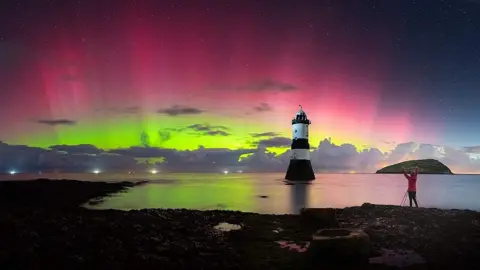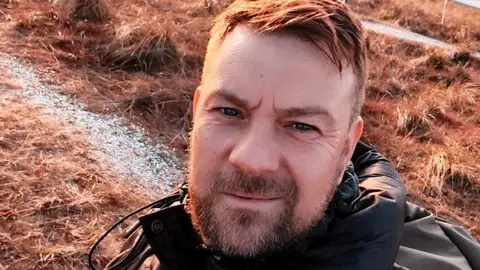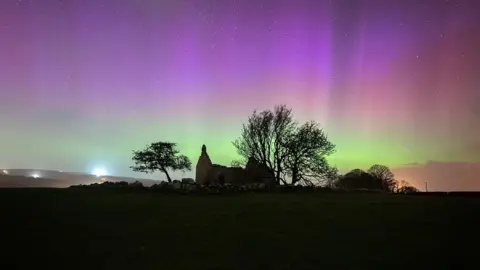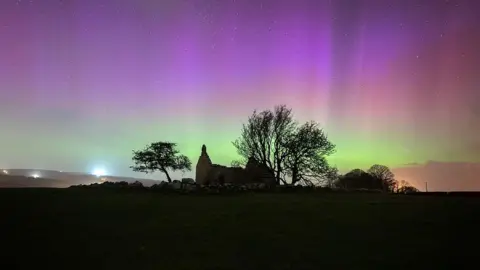Northern Lights: Will 2024 be the best year to see it?
 Gareth Mon Jones
Gareth Mon JonesPeople looking up at the skies in Wales have been lucky enough to spot some fantastic displays of the Northern Lights in recent years.
This has been made easier by more areas being designated Dark Sky Reserves or zones.
Tourism to witness the spectacle is increasingly popular, in part through the sharing of some striking images on social media.
Could 2024 be one of the best years to spot the celestial phenomenon?
Why could now be the best time?
Changes in the sun are set to make the appearance of the lights more likely.
A solar cycle is an approximately 11-year period over which activity on the sun waxes and wanes.
This year will mark almost the mid-point of Solar Cycle 25, and it is heading into its most active phase.
 Gareth Mon Jones
Gareth Mon JonesThe cycle began in 2019 according to NASA, and with magnetic changes comes a rise in the amount of activity on the sun's surface.
It means more sunspots - with X-rays and magnetic fields sent towards Earth, causing geo-magnetic storms which produce auroras, another name for the Northern Lights.
What's the best way to try to see it?
To catch a glimpse, you could try one of Wales' five dark sky areas accredited by DarkSky International.
The Bannau Brycheiniog (Brecon Beacons) and Eryri (Snowdonia) national parks are both dark sky reserves and the Elan Valley estate in Powys is a dark sky park.
There is also Ynys Elli/Bardsey Island in Gwynedd and Presteigne and Norton in Powys which are a dark sky sanctuary and a dark sky community.
However, in order to have the best chance of spotting lights in Wales, the advice is to get as far north, near to a coast and away from manmade light sources as possible.
Is Anglesey the best place to capture it?
Keen photographer Gareth Mon Jones is perfectly placed to capture the best the night skies have to offer.
From Llangefni, Anglesey, he started taking photographs about 10 years ago partly as a way to "stop going to the pub" and partly in the aftermath of his father's death.
"I was going out for sunsets in the winter and then I stayed after sunset and saw all the stars come out, and I thought 'wow, this is amazing'," he said.
"It took me back to my early days fishing with my father on the rocks. He used to say 'stand over there on the rocks, don't move'. And the only thing I could have for company was the stars. It took me back to that nice place."
 Gareth Mon Jones
Gareth Mon JonesGareth's first encounter with the aurora came as a complete surprise.
"I was beside myself, really, because I thought this can't be possible, this can't be happening on Anglesey.
"I've only seen the Northern Lights on Facebook pictures of Iceland or Norway or Scandinavian places.
"The only thing that made me think it was unreal was the light colour that was coming off the aurora was white lights coming off the horizon.
"In Iceland it seems to be green and red. You're further north, so all this colour tends to happen on a higher latitude and here in Wales we just get like light pillars.... I took a picture and then saw reds and greens and thought 'wow, this is the Northern Lights. From Anglesey'."
Because viewers are unlikely to see the lights in full colour with just the naked eye, Gareth has sometimes been accused of digitally altering his images, and he stresses it is important for people to understand they will usually need a camera to see the full effect when out in Wales.
But high-tech equipment is not necessary to capture the phenomenon, he stresses.
"You can take the aurora now with colour on a mobile phone," he said.
"If you put your little iPhone into manual mode and put it into super-sensitivity, what they call the ISO for sensitivity of light, and then the aperture as wide as possible - as wide as possible means a lower number."
He personally recommends Penmon Point lighthouse as a promising spot for a variety of natural phenomena - including, in the summer months, bioluminescent plankton in the sea - as the beach is in the south-east of the isle but has a north-facing beach.
Where can you see the Northern Lights in Wales?
Other good spots on Anglesey include Amlwch, Cemaes Bay, Benllech and Moelfre.
But all is not lost if you aren't fortunate enough to live within easy travelling distance of Anglesey.
 Mathew Browne
Mathew BrowneLast month, Mathew Browne from Carmarthenshire won a Northern Lights Photographer of the Year award for his image of the lights over Paxton's Tower in the county, proving with the right timing, the display can be appreciated all over the country.
"I've seen photographs from the Brecon Beacons. This year somebody picked them up from the Gower and even as far south as Cornwall," says Gareth.
He said one display was seen from high places "anywhere in south Wales" and Pembroke.
"Basically it's just getting somewhere dark and somewhere quite high if you're inland," he added.
 Gareth Mon Jones
Gareth Mon JonesModern technology has also made a big difference.
"There's load of aurora apps these days as well and that's made my life super, I wouldn't say easy, but super useful to know when they're going to happen, or the prediction of a [magnetic] storm that's coming in," Gareth explains.
Things like this have "without doubt" encouraged a growth in aurora spotters, although it can be a double-edged sword, according to Gareth.
This happens when people arrive without being respectful of the natural environment and leave rubbish behind.
